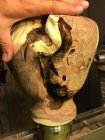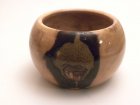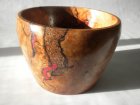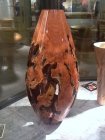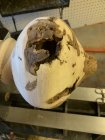Newbie disclaimer - I've been turning for less than a year, so I apologize if this is a stupid question / obvious answer.
I've got a gorgeous mesquite burl with several deep voids in it, the most concerning is at the base (see pics). Ordinarily I'd fill it with resin, but my otherwise quite reasonable and intelligent wife has decided she hates resin and since this is a present for her, my hands are tied.
Turning the exterior was fine, but I'm worried that without somehow stabilizing the voids, once I start hollowing the middle the piece will loose structural integrity and break apart (not to brag or anything, but I've managed to become quite proficient at taking beautiful pieces of mesquite and mangling them into unrecognizable fragments and shavings...)
Two thoughts I had -
1) 'Painting' the inside of the voids with CA glue with +/- heavy coating of shellac
2) Wrapping the outside with nylon strap and ratchet to mitigate centripetal forces (this makes sense in my head, I can also see it catastrophically failing in my head)
Any advice? Thanks
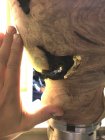
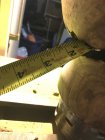
I've got a gorgeous mesquite burl with several deep voids in it, the most concerning is at the base (see pics). Ordinarily I'd fill it with resin, but my otherwise quite reasonable and intelligent wife has decided she hates resin and since this is a present for her, my hands are tied.
Turning the exterior was fine, but I'm worried that without somehow stabilizing the voids, once I start hollowing the middle the piece will loose structural integrity and break apart (not to brag or anything, but I've managed to become quite proficient at taking beautiful pieces of mesquite and mangling them into unrecognizable fragments and shavings...)
Two thoughts I had -
1) 'Painting' the inside of the voids with CA glue with +/- heavy coating of shellac
2) Wrapping the outside with nylon strap and ratchet to mitigate centripetal forces (this makes sense in my head, I can also see it catastrophically failing in my head)
Any advice? Thanks




